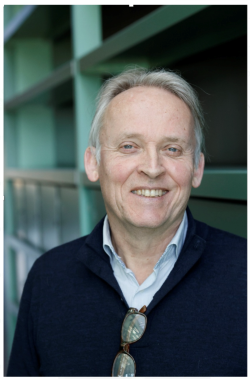Quantum behaviour in a classical device
Bert Kappen, Department of Neuroscience, Radboud University
 We recently showed the possibility to realize a stochastic neural network at atomic scale (Kiraly et al. 2021). The spins in this network are bi-stable atoms that stochastically switch between two states (up and down). Each neuron is characterized by the asymmetry (the probability to be in the up state minus down state) and mean residence time (the mean time between switches). Residence times of different spins can differ many orders of magnitude. Previously, we proposed that fast spins encode the firing or non-firing of neurons and slow spins encode binary learning elements, ie. synapses.
We recently showed the possibility to realize a stochastic neural network at atomic scale (Kiraly et al. 2021). The spins in this network are bi-stable atoms that stochastically switch between two states (up and down). Each neuron is characterized by the asymmetry (the probability to be in the up state minus down state) and mean residence time (the mean time between switches). Residence times of different spins can differ many orders of magnitude. Previously, we proposed that fast spins encode the firing or non-firing of neurons and slow spins encode binary learning elements, ie. synapses.
It turns out that the interaction between such spins can be elegantly described using a quantum mechanical language. The mapping is very similar to the mapping of a d dimensional stationary quantum system on a d+1 dimensional classical system (but in the reverse direction). The extra dimension is imaginary time. Each spin is described as a qubit that is charcterized by Pauli matrices sigmaz and sigmax and a network of such spins as a quantum density matrix ρ ∝ exp(β H). H is a quantum Hamiltonian and β is time. The large time behaviour of the stochastic system is equivalent to the ground state of H. H encodes the interactions between the qubits.
The implication of this mapping is that this classical stochastic spin system can implement a quantum Boltzmann machine (Kappen 2020). We will briefly explain the QBM and demonstrate how the quantum Hamiltonian can be learned from these classical time series data. Quantum entanglement in this system can in principle exceed classical correlation, provided that proper measurements can be made.